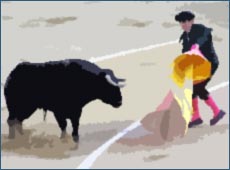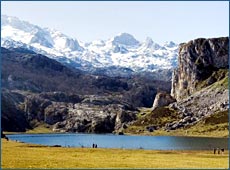|
|
|
|
 |
|
| |
| » |
Barcelona's Sagrada Familia |
» |
Feria de Abril, Seville |
| » |
Prado Museum, Madrid |
» |
Picos de Europa |
| » |
Alhambra Palace – Granada |
» |
Balearic Islands |
| » |
Guggenheim Museum Bilbao |
» |
Cordoba and the Mezquita |
| » |
La Tomatina Festival, Buñol |
» |
Toledo |
|
|
|
 |
| |
| Picos de Europa is the first Spanish National Park to receive this classification. Its origin dates back to 1918, when don Pedro Pidal, Marquis of Villaviciosa, helped establish the law to create Montaña de Covadonga National Park. Since 30 May 1935, it has been called Picos de Europa National Park. |
| |
| The Picos de Europa consists of three important massifs that go by the names of the Eastern Massif or Andara, Central Massif or Urrielles and Western Massif or Cornión. The climate is characterized by humidity and constant rainfall, a fact that is determined by its proximity to the sea (barely 20 kilometres). The presence of snow is accentuated during the winter months, however, it is not unusual for there to be perpetual snow. The Picos de Europa’s special climate means that there are frequent fog banks, something that is greatly feared by mountaineers. As for its orography, the Park has an exceptional relief, where high summits alternate with deep gorges and canyons. The Picos de Europa boasts 200 heights of over 2,000 metres, and vertical drops of over 2,300 m. The Central Massif is the most abrupt of the three that make up the Park and the greatest heights can be found there: Torrecerredo (2,646 m), the highest summit in the Picos, Naranjo de Bulnes (2,519 m) or Pico Tesorero (2,570 m). The Western Massif is the most extensive, and it possesses high summits, like Peña Santa de Castilla (2,596 m), intermingled with meadows, hillside forests, beech and oak groves and moors. The famous Covadonga lakes can be found on this massif. The Eastern massif, shorter and lower, blends sharp crag with green pastures. The de Europa Picos is crossed by four rivers channelled in deep gorges: la Hermida defile, crossed by the river Deva; los Beyos defile, by the river Sella; la 'Garganta Divina',(Divine Gorge) through which the river Cares runs, and La India defiles, though which the river Duje flows. There are numerous viewpoints in the Picos de Europa from where you can admire its beauty. An interesting alternative is to use Fuentedé funicular, via which you can go up to a height of more than 1,800 metres above sea level. |
| |
|
|
|



